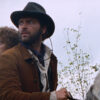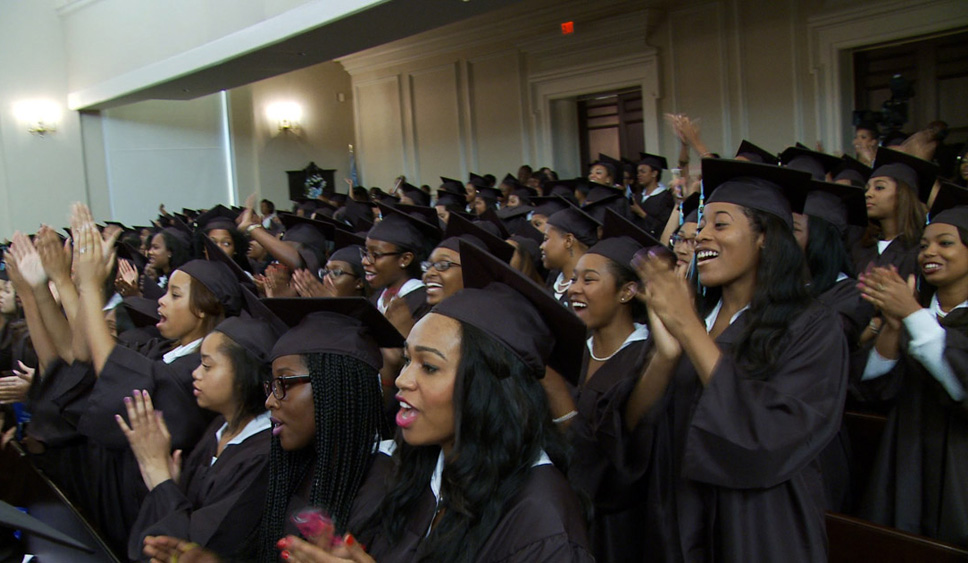After previously immersing himself into the pressure cookers of the famed Manhattan kitchen in “Le Cirque: A Table in Heaven” and the media desk of the New York Times for “Page One,” Andrew Rossi has become accustomed to high heat. But even the filmmaker was taken aback when he ventured out into the stifling heat of California’s Death Valley to Deep Springs, the most far-flung university he stops at in “Ivory Tower,” the comprehensive new film about the dilemma facing the current generation of college students who must ask themselves more and more whether a degree is worth the rising cost of tuition.
Yet Rossi’s visit to the Mojave Desert may lead audiences to see an oasis in Deep Springs, a two-year school with a class size of no more than 30 students who engage in deep philosophical debates about the ideas of Hegel after they’ve completed their field work to serve the local community, a tradeoff that makes their education free. It’s just one of the many alternative models of higher education that “Ivory Tower” comes across in criss-crossing the country from Harvard to San Jose State, tracking the evolution of universities from a haven for intellectual pursuit to an increasingly cumbersome financial burden for those skeptical that it will result in a steady job as it has in previous eras.
In his travels, Rossi meets students ranging from David Boone, a freshman at Harvard from a lower income neighborhood in Cleveland who is just happy to have a bed in his dorm after never having had one before, to Stefanie, a Hunter College graduate who amassed $140,000 in student loan debt while achieving her masters degree with no job to show for it. And while “Ivory Tower” covers colleges of every stripe and students from every background, what emerges is a united portrait of those who want an education fighting harder than ever to get one, most significantly in the halls of the filmmaker’s hometown school of Cooper Union in New York where the film watches as the trustees of the art, architecture and engineering school decide to charge tuition for the first time in its 154-year history, leading to mass protests from its pupils.
While in Los Angeles, the director spoke about how the film emerged from his continuing interest in institutions, filming a sit-in at Cooper Union, and how making an issue-oriented documentary approach affected how he went about telling the story.

After I made “Page One,” I was looking for another important cultural institution that was at a crossroads of change. Higher education immediately stood out. It was the moment when student loan debt exceeded $1 trillion and Peter Thiel was offering people $100,000 to drop out of college and also when massive open online courses were getting a lot of attention as potential way to reduce costs and increase access to college or to higher learning. As somebody who had a very positive undergraduate experience, hearing all that negative conversation about college struck me as similar to the way people had responded to the idea that the New York Times was having difficulty or that newspapers in general might suffer a crisis. This was the perfect opportunity to go underground and see what students and faculty are experiencing.
In your features such as “Page One,” you’ve often been able to embed yourself in a single location and tell the larger story outside of it, but here you’re criss-crossing the country. Was it a bit of reverse-engineering?
Precisely. In a way, the protagonist is the American college as a whole, so we needed to find different entry points into different layers of the sector, including community colleges, public universities, small liberal arts colleges, like Wesleyan, the elite schools like Stanford and Harvard, then the unique programs like Deep Springs [in California] and the historically black colleges [such as Spelman in Atlanta]. It was a process of creating a multi-faceted portrait that would then come together. Even at Cooper Union, for example, some people really respond to the emotional pitch of that story and see the students fighting back and occupying the president’s office, but if we had only shot at Cooper, I feel that we would have lost some of the opportunity to really burrow down into the structural problems of higher education and look at the cost disease that has resulted in the business model of certain schools that has resulted in such high tuition and a reduction in state funding and all those other factors.
Was there a certain touchstone you had so you could keep your central theme straight?
We were drawn also to several authors and thinkers on this topic such as Andrew Delbanco, who wrote “College: What It Was, Is, and Should Be.” He informed a lot of our investigation and he looks at the historical evolution of college from its origins at Harvard in 1636 and the notion of the lecture being like a sermon to inspire students on to a more meaningful life. In a way, we were telling a chronological, historical story about the evolution of college, from Harvard on, then we filled in the portrait from there.
There’s one student, David Boone, a freshman at Harvard, who you actually follow home from school. Out of all the students you spoke to, why was he the one you focused on?
When we were filming in the CS50 class, we followed 10 or 15 different students and filmed with them extensively. We felt that David’s story represented the ideal. He is a fantastic expression of college as this engine of social mobility. Getting into Harvard not only changes his life, but the life of his whole family and in some ways, his community in Cleveland [where] he’s seen as a role model. There was a level of complexity to his story and he represented so much, that that’s why we chose to follow his story finally versus those of some of the other students, of which there were many.
Was it interesting to reconcile the memories of when you went to school with walking onto all these different campuses today?
First off, you walk into a lecture hall and it’s a sea of blue light emanating from student’s laptops. That is quite different from when I was in school 20 years ago. When I graduated in ’98, laptops were just starting to be used, so that was really different, just visually, and I wanted to capture that. I also was impressed at how serious the students we met were about their studies, and what a firm head they had on their shoulders. I was continually inspired by the people that we were filming.
It’s noticeable during the Cooper Union protests when students stage a sit-in inside the president’s office and obviously, the spirit of the ’60s is there, but there’s also a calm, studied vibe from the students that’s different.
That was fascinating. I was really impressed at how they viewed the occupation as a physically demanding process, but also an intellectually inspiring one. They conducted seminars on the future of education while they were in the president’s office on ideas of management and activism. There’s an architecture student from Cooper Union, Bob Estrin, who stands up when the president visits the occupiers and he is cogent and poised. It’s interesting because he looks like a hippie — he’s got the long hair down to his shoulders — but he is very sober in his tone and so reasoned and rational, he doesn’t sound like a pie-in-the-sky agitator. It’s exactly as you say – he embodies the idealism of the 60’s, but more rational, postmodern approach to activism and a realism about what they’re doing in his delivery.

We were in filming in San Francisco at [Peter Thiel’s] UnCollege when the students occupied the office. We came back at the end of that week and I found Victoria [Sobel, a student at Cooper Union] outside the main building and interviewed her and we were able to go in a couple of times into the office, but a lot of the footage, particularly when they actually occupied, came from Mauricio Higuera, who was one of the activists and had a 5D camera with him. He was able to get amazing footage, so we wove that in.
During the time you were making this, did the public debate going on outside of your filming ultimately affect what you wanted to say with it once you got to editing it?
Certainly, this film is not necessarily breaking news, but what’s novel about it is putting all these disparate arguments and ideas into one big tent. We see the film as a 90-minute resource that’s as comprehensive as we could make it, to empower students and parents and anyone who is concerned with higher education, to understand the context of how we got here to this point where tuition is so expensive and state funding has gone down so much and what the possible alternatives are.
While we were making the movie, there were different studies coming out, so we were trying to be very attuned to those, Particularly, the level of enthusiasm for massive open online courses shifted tremendously. When we first started shooting at the end of 2012, people really were believing that MOOCs could totally transform the landscape of higher education. There was a sense of existential threat among professors on some campuses that they could be replaced by MOOCs. Then, by the summer of 2013, the results from the Udacity Pilot [program at San Jose State where introductory college courses were offered online to the masses] came out, and the pass rates were so abysmal that suddenly everybody felt quite differently. The proclamations of demise for the traditional university, a sense of apocalypse had shifted. That gave us more opportunity to talk about student debt and some of the other problems in the film that have remained consistent throughout the last couple years.
Since education is a goal of the film, does it change how you tell the story? Your previous films have concentrated more on individual personalities.
Definitely. “Page One” is really, as you say, is a character portrait of David Carr and other members of the media desk first, then secondarily, it resonates a much broader debate about the future of print journalism and the ramifications of certain digital initiatives and the insights on those levels come in the form of character development. I really enjoyed making that film, but some people wanted more analysis, more nuts and bolts explanation and I think that partially formed the creation of this film in that “Ivory Tower” really tries to provide a principal and clear explication of how we got to this point with tuition, historical context and a balanced view of what the alternatives are.
What’s it been like to be going back to college campuses to show the film?
Every Q and A is full of passion and, in some cases, anger about the way that higher education and student loan debt is right now, and questions about different things that we could cover in our social action campaign. Parents and students are coming up to me after the screening and just telling their own personal stories. It feels like a real rallying point, like it’s a film that can really address people’s feelings of loneliness or frustration and reinforces that they’re not alone and that this is a common experience.
“Ivory Tower” opens on June 13th in Los Angeles at the Landmark and in New York at the Angelika Film Center. It will expand across the country in the following weeks. A full list of theaters and dates can be found here.




